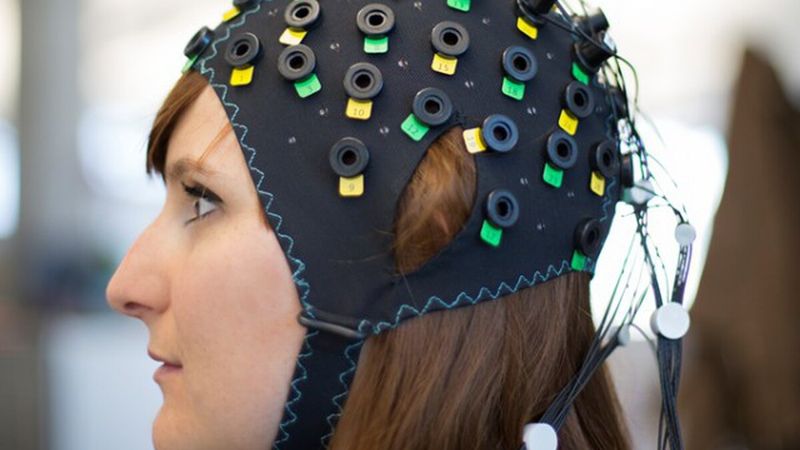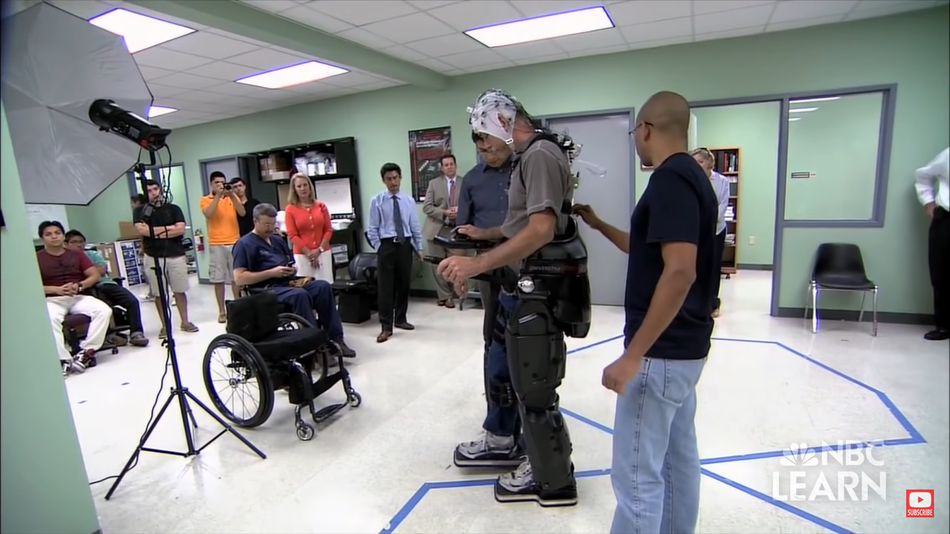Next-Generation Medical Devices for Brain-Computer Interfaces
Article #4 of Improving Lives with Digital Healthcare Series: Transferring information directly between the human brain and a computer can unlock the possibilities of using machines as extended parts of the human body.

Image credit: Wyss Center para
This is the fourth article in an 8-part series featuring articles on Improving Lives with Digital Healthcare. The series focuses on electronic systems that enable innovation in the healthcare industry. This series is sponsored by Mouser Electronics. Through the sponsorship, Mouser Electronics shares its passion for technologies that enable smarter and connected applications.
Brain-Computer Interface (BCI) is a means to establish direct communication between a human brain and a computer to allow the machine to sense and be controlled by thoughts converted to electrical signals. The technology has its potential applications in education, gaming, entertainment, and above all, in medical science. BCI devices can help people with paralysis or severe motor disabilities control prosthetic devices.
Artificial Intelligence (AI) and Machine Learning (ML) combined with Digital Signal Processing (DSP) enable greater accuracy and reliability in evaluating and developing BCI applications. In this article, we examine this field, and some of the critical electronic components within the signal chain required to measure brain waves, bodily functions, and how everything is put together.
Brain-Computer Interface and Electroencephalograms
The human brain produces oscillating electronic voltages. The typical value of these voltages is minimal, measured in units on the order of millionths of volt (microVolts). The most common way to collect and analyze these brain-wave voltages is through an electroencephalogram (EEG). An EEG is an electrophysiological monitoring method to record electrical activity on the scalp. It captures signals directly related to the brain waves happening directly under the skull.

BCI via an EEG can be unidirectional (one-way) or bidirectional (two-way). Bidirectional BCI allows information to flow both ways, thus opening the brain to feedback and future adjustments. EEGs can be invasive, semi-invasive, or non-invasive. Invasive EEGs involve directly locating and connecting devices to the human brain. Semi-invasive EEGs can be placed between the brain and the skull. Non-invasive BCI, on the other hand, is generally done by a cap placed on the skull with various electrodes.
EEGs provide temporal resolution of 0.05 seconds and spatial resolutions on the order of 10 mm. Other techniques, besides the electrical technique employed by EEGs, can be used to gather data. These techniques can employ magnetic, metabolic, or other forms.
Brain waves are classified into one of five general categories based on their frequency as shown in Table 1. Medical researchers break these frequencies into bands because each band represents a distinct way a brain operates in performing its functions. For example, critical activities such as memory and recollection happen especially, but not exclusively, in the theta band. Researchers use these bands to analyze what might be going on if appearing signals are too little, too great, or in an optimal amount.
Band | Frequency (Hz) |
Delta | 0.5-3 |
Theta | 3-8 |
Alpha | 8-12 |
Beta | 12-38 |
Gamma | 38-42 |
Table 1: The five general categories of brain wave bands. Each frequency range is a nominal value and not necessarily absolute.
An EEG acquires the brainwave signals and digitizes them. They are then signal-processed, where features can be extracted and translation algorithms perform classifications. They also can be printed out or recorded for future analysis.
Signal outputs can be utilized to form device commands to provide instructions related to motor control, locomotion/movement, and environmental conditions or stimuli. BCI helps allow disabled people to have more control of their external environments.
Brain-Computer Interface and the Human Condition
Because of human biology, our senses and our intelligence have fundamental limitations. It is conceivable that BCI and implants could enhance or provide new sensory information and augment biological capabilities.
A primary consideration in merging man and machine is understanding how the machine and the human interact and exchange information between themselves on a real-time basis since they operate in two different domains. More work remains to be done to understand how the mutual coordination of individually-addressable neurons directing the brain can function in its environment while maintaining coordination with the digitally-addressable domain of the interface.
Brain-Computer Interface Research
BCI is also being investigated to look at areas to help humanity, including restoring or enhancing human vision, motor recovery for disabled limbs, and brain mapping to assist in restoring and correcting various neurological damage and disorders. Brain mapping can lead to a greater understanding of seeing how human thought is realized to human action. It can lead to augmented human learning, new or enhanced human sensing, and new embedded autonomous neural systems. Let’s look at two examples of where BCI can continue to evolve and lead.
Superhuman Cognition
Billionaire Elon Musk is actively investigating BCI issues. He is one of the founders of Neuralink Corp., a neurotechnology company developing implantable brain-machine interfaces. Neuralink is working on building better tools for communicating with the brain. These founders believe that, with the right team, the applications for this technology are limitless. Neuralink is exploring the possibility of embedding into the brain ultrafine electronic threads that permit neural activity. One of Musk’s stated goals is to achieve “superhuman cognition.”
Inventor and futurist Ray Kurzweil believes that human intelligence is characterized by its remarkable ability to recognize patterns. He views human intelligence as an evolutionary, self-organizing hierarchical system operating in the context of a biological pattern-recognition machine. Musk is motivated to achieve superhuman cognition based upon his desire for humanity to negotiate more proficiently in understanding the emergence and spread of more powerful AI, which is becoming ever more adept in its excellence at pattern recognition.
New Senses
When looking at how BCI can enhance human senses, one can consider the case of Neil Harbisson, cofounder of the Cyber Foundation. He has been recognized as the world’s first cyborg. Born color-blind, Harbisson has permanently installed an antenna into his skull so that he can now literally hear color, substituting his auditory sense in place of his visual limitation. Harbisson is actively advocating a future in which humans incorporate technology into their bodies.
Sensor Hubs
Supporting these efforts, sensor hubs are being employed in various ways to collect additional biometric information beyond BCI. Sensor hubs use multiple sensors and a microcontroller to collect and analyze numerous human parameters not directly accessed by brain waves. These can include collecting information about the human pulse heart rate, pulse blood oxygen saturation (SpO2), and estimated blood pressure.
Ensuring High-Quality Data
Because brain signals are so small, the entire electronic signal chain is prioritized in its design to minimize noisy, spurious, or artifact signals. The patient might induce these sources through their physical movements, sweating, eye movements, heart rhythms, and the like. Electrical errors can result from 50Hz/60Hz noise, electrode-skin contact issues, and cable movements.
Successful electronic component selection will focus on utilizing high-precision, low-noise, high-resolution signal chain products. Low-noise amplifiers (LNA), unity-gain buffers, and precision Analog-to-Digital Converters (ADCs) are chosen to prevent the introduction of unwanted signals into the chain while providing the ability to resolve data accurately and reliably. Differential amplifiers and bandpass filters are also employed to ensure only high-quality data is transmitted. Appropriate connectors and jumpers are needed to get accurate signals into and out of the brain.
Artificial Intelligence with Brain-Computer Interface
AI and its subsets, including ML and deep learning (DL), are enabling approaches in EEG-based BCIs. DL can offer automatic classifications of EEG signals. This effort allows for the data to be utilized in various applications and other Convolutional Neural Networks (CNN) training. At present, human expertise supports AI approaches. The desire is to eliminate artifacts, increase the data quality, and continue to realize gains in AI technology so that measured brain wave signals can continue to exhibit exponential increases in their ability to be classified by AI through DL techniques.
Electronic Components by Molex Enabling Brain-Computer Interface Applications
Molex 0.25mm-Pitch Premo-Flex Jumpers offer reliable connectivity in a compact design for tight packaging applications. The jumpers deliver durable, ultra-flexible, cost-effective solutions for printed circuit board (PCB) connections in virtually any industry. These FFC/FPC jumpers are available in standard lengths, pitches, and circuit sizes to accommodate a wide range of flexible interconnect requirements between two PCBs. Molex 0.25mm-Pitch Premo-Flex Jumpers are ideal for medical applications, including patient monitoring for signals, including the body’s condition, surgical equipment, and telehealth. 
Molex 0.25mm Pitch Easy-On FPC Connectors offer a 50 V voltage rating, 50 MΩ insulation resistance, and 150 V AC dielectric withstanding voltage. These connectors provide designers with a range of sizes and styles to accommodate other PCB components. Molex 0.25 mm Pitch Easy-On FPC Connectors are ideal for next-generation medical devices.
Conclusion
EEG-based BCI relies on high-performance electronic signal chains. Careful consideration of all critical electronic components, including reliable connectivity in compact designs, are needed to accurately measure EEG and other bodily functions. AI and DL techniques enable dynamic EEG data to receive better interpretations and allow humanity to realize more benefits from BCI.
This article was initially published by Mouser and Molex in an e-magazine. It has been substantially edited by the Wevolver team and Electrical Engineer Ravi Y Rao. It's the fourth article from the Improving Lives with Digital Healthcare Series. Future articles will introduce readers to some more interesting applications of electronics in healthcare.
Introductory article covered the fundamentals of biomedical instruments and the ways in which digitizing them is transforming healthcare.
Article 1 explored the design challenges in Consumer and Medical wearables. It showcased how technologies once limited to hospitals are now made available to everyone for monitoring personal health.
Article 2 was focused on the present state of robotic surgery. It explained how advancements in robotics and communication, combined with the expertise of surgeons, enable customized treatments for patients.
Article 3 presents an overview of how new sensing, communication, and energy systems, engineered for the healthcare sector can be used to transform cardiovascular disease treatment procedures.
Article 4 examined Brain-Computer Interfaces and how they help in enhancing human vision, motor recovery for disabled limbs, and more.
Article 5 featured an informative webchat between Mike Depp, and Glen Capek from Molex, as they discussed trends in flexible electronics driving new solutions for medical wearables applications.
Article 6 discussed how immersive digital technologies like Augmented Reality (AR) and Virtual Reality (VR) make medical learning more engaging through lifelike experiences.
Final article was a roundup of the entire series that tried to give readers a snapshot of the potential of medical technologies in the present times.
About the sponsor: Mouser Electronics
Mouser Electronics is a worldwide leading authorized distributor of semiconductors and electronic components for over 1,100 manufacturer brands. They specialize in the rapid introduction of new products and technologies for design engineers and buyers. Their extensive product offering includes semiconductors, interconnects, passives, and electromechanical components.
References
[1] Next-gen devices for Brain-Computer Interfaces, Mouser, [Online], Available from: https://www.mouser.com/blog/next-generation-medical-devices-bci

